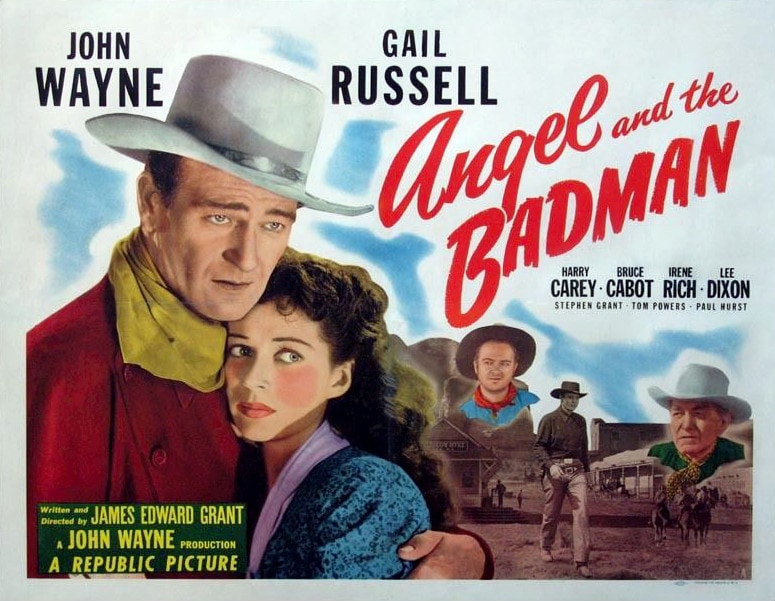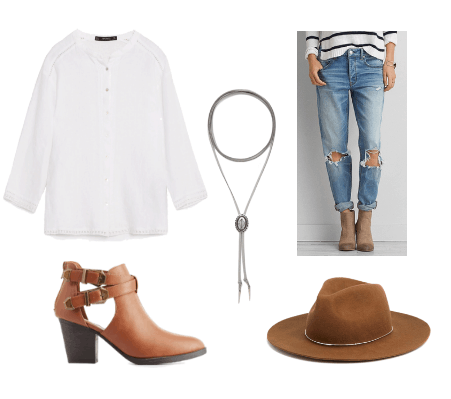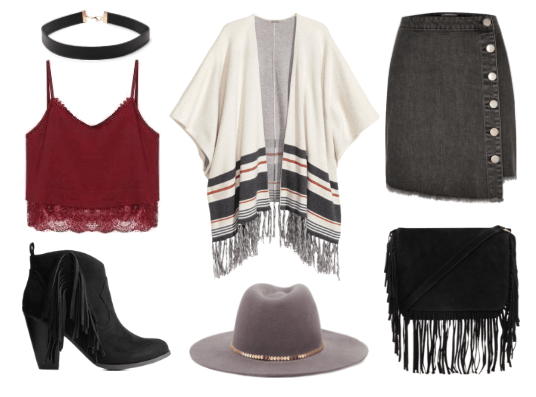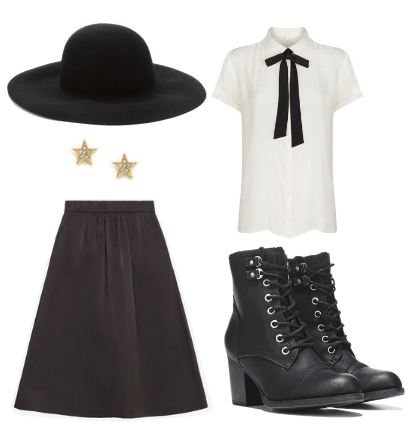
There’s no shortage of Wild West movies and TV shows out there. My parents in particular are big fans of Bonanza and The Rifleman, so I’m no stranger to the American frontier as it appears on the silver screen. Of course, the costumes worn by John Wayne and James Arness are often pretty far removed from actual old west garments.
Even though they may not match our mental pictures of Western style, the clothes of the old west were still fascinating and unique. They made a small comeback in the 1970s, what with all the suede and fringe, but there’s so much more inspiration to be found beyond stetsons and cowboy boots.
Table of Contents
Old West Fashion Overview:
First off, let’s pin down what we mean by Old West, since the beginning and end of the era is super vague. For, instance the town of Independence, Missouri was founded as early as 1827, and the last stagecoach robbery happened as late as 1916. But since the American Civil War ended in 1865, I’m mostly going to focus on the American West post-war.
That aside, we should also differentiate the Old West from the Wild West. Westerns, as a genre, popularized the idea of the Wild West, as they offered such a romanticized idea of the frontier, where the cowboy or gunslinger was a knight-like figure who fought outlaws and saved damsels in distress. Of course, most ideas about the Wild West are pure myth: Native Americans rarely clashed with settlers, bank-robbers were few and far between, and the American ideal of the cowboy was preceded by the Mexican vaquero by some 200 years.
Vaqueros actually created many of the staples of cowboy attire, and by the late 1800s they had a very distinct style of clothing. They wore sombreros to shield themselves from the sun, sarapes or ponchos for warmth and protection, and short jackets made of cloth or leather that they would decorate with braids or embroidery. They also donned cloth leggings under pants that buttoned down the outside seam with silver conchos. These pants could be either short or long, though long ones were usually left unbuttoned below the knee to show off their botas, or leather boot covers that wrapped around the lower leg. Vaqueros also traditionally wore a sash around their waists in place of a belt.
American pioneer cowboys usually wore loose cotton shirts and wool trousers, vests with pockets, and canvas or wool jackets for warmth. They usually wore chaps, though the original style was closer to a loose pair of leather pants than the batwing style we see in Western movies. Also, contrary to popular belief, there was no specific style of cowboy hat, as anything with a wide brim would do. A cowboy’s boots were the most important part of their attire, though, and cowboys often saved up their wages for months to have custom boots made. Additionally, bandanas were often worn, as they were a great multipurpose accessory.
As for settlers and townspeople, the common Victorian clothing of the times was usually worn, though the style and opulence depended entirely on the wealth of the wearer.
Outfits Inspired by the Old West:
So, without further ado, lets get to our old west looks. For these three outfits, I still varied the levels of historical accuracy, as per usual, but I also wanted to explore the styles of different ‘characters’ common in the Wild West.
If you only want to go a little bit westward, look number one is for you. If you’re ready to earn your spurs, look to outfit two. And if you’re truly a pioneering individual, check out look number three.
Outfit #1: Calamity Jane

Products: Shirt, Jeans, Boots, Hat, Necklace
I know that this look is probably the most recognizably “cowboy,” but, in actuality, it’s the least historically accurate. However, since I like to confuse people (and myself) I wanted to do a look that played off of these fashion stereotypes. Most cowboys, especially early on, didn’t wear jeans, since Levi’s didn’t start selling blue jeans until 1873. Prior to that, cowboys and miners either wore riveted canvas pants or secondhand wool trousers.
The stereotypical cowboy hat is also pretty far from what was actually worn in the old west. Bowler hats were actually the most popular in the 1800s and even when Stetson started making hats they didn’t look like what we think of when we think Stetsons today. Lastly: bolo ties, which we tend to think of as pretty western, weren’t actually patented until 1940. A bandana would be far more accurate, but I thought that might make this look a little too costume-y.
Cowboy boots are actually pretty spot on, though. The style was designed for practicality, with a pointed toe and high heel to help the wearer get in and out of stirrups. This leather bootie is a fun modern take on the style. Finally, a linen shirt is, as far as I know, acceptable cowboy attire, and this one has some fun lace detailing.
Outfit #2: Home on the Range

Products: Top, Skirt, Poncho, Boots, Hat, Purse, Choker
As I mentioned earlier, the real OCs (original cowboys) were Mexican vaqueros, who perfectly combined practicality with style. I picked this buttoned skirt as a reference to the vaquero style concho pants. Sarapes and ponchos were also common vaquero attire, and I paired this one with a similarly colored camisole top to brighten the look. Though sombreros were the original cowboy hat, a felted fedora is much more in keeping with the times.
Again, a bandana would have been worn around the neck to keep off the dust, but I substituted a simple choker to accessorize. Now, we tend to associate fringed leather or suede with western clothing, but I personally can’t speak to the historical accuracy of it. There are old paintings of vaqueros which feature fringed clothing, but personally I blame Buffalo Bill, whose stage costumes for his Wild West Show featured a lot of fringing. In any case, I finished off this look with fringed boots and a matching cross body bag for some added flair.
Outfit #3: Go West Young Man

Products: Shirt, Skirt, Boots, Hat, Earrings
Of course, the Old West wasn’t just cowboys and vaqueros roaming the plains, but most other folk wore the typical clothing of the times (the times being the mid to late 1800s). However, I couldn’t leave out that other famous Wild West archetype: the sheriff. I also mixed in a little bit of frontier women’s clothing and ended up with something that reminds me weirdly of True Grit. So…success?
In any case, most respectable men in the west wore a button down shirt with a tie of some sort, so this bow blouse is pretty in keeping with the times. As for women, Victorian clothing was still mostly the norm, though lots of ladies wore blouses and skirts rather than full gowns. Annie Oakley, famous wild west marksman, tended to wear calf length skirts like this black midi.
High button boots were still a popular shoe style, but those are extremely hard to find these days. Instead, I picked these heeled booties that I thought had a similar feel. A wide brim black hat acts kind of like a compromise between a bowler hat and a Stetson. Since a sheriff’s badge might be a strange accessory (each to their own, though), small gold star earrings are a more subtle way of letting people know who’s in charge.
More Styles by the Decade:
Want to travel to a different decade with your style? See my other posts on’90s fashion, ’80s fashion, ’70s fashion, ’60s fashion, ’50s fashion, ’40s fashion, ’30s fashion, ’20s fashion, ’10s fashion, 1900s fashion, ancient Greece and Rome fashion, American Revolution fashion, and Korean Hanbok fashion for more!
What’s your opinion on Old West Fashion?
Are you planning to incorporate western style into your look this year? Are there any fashion trends you think I should have included? What’s your favorite look? Let us know in the comments, we’d love to hear from you!

love this post
I love these history themed articles so much! I hope you do more! Have you thought about inspiration from women in different organizations during WW2? Red Cross, Pilots, munition workers, land girls, ect
Allways love your informative introductions and the vaquero outfit is really cool
Oh, I love the way you did this~ And the sheriff outfit is so cute and clever!
Great post dear! 😉